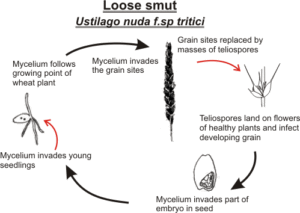It is one of the common disease of wheat caused by Ustilago tritici. Smut fungi belonging to order Ustilaginales are parasites both on monocots and dicots. Since they impart sooty appearance due to production of black spore mass they are generally described as smut fungi.
The mycelium of these fungi is parasitic dikaryotic and quite often intercellular in the host plant, may be systemic or localized. Ustilaginales as a group do not possess orgainsed sex- organs but dikaryotization is brought about by the fusion of mycelial hyphae or by fusion of basidiospores or sporidia. Chlamydospores, the reproductive structures have been designated variably
Symptoms:
The affected plant is converted into a black mass of spores and no grains are formed. The infection brings about physiological and structural changes in the host.
In most of the varieties under cultivation the growth of the plant and its general appearance is not affected in any way until ears have appeared. But in some varieties, abnormalities are seen in the flag leaves.
The disease is called loose smut because the spores produced on smutted heads are easily removed by wind and rain. Typically, after a short while, only the bare, sooty, flower stocks remain. In some cases, the seed head is only partially infected. Prior to heading, diseased plants may have dark green leaves with chlorotic streaks, but this symptom generally goes unnoticed. Seed with no visible symptoms can be infected with the fungus.
Disease Cycle:
The fungus survives as dormant mycelium in symptomless seed. When infected seed germinates, the fungus systemically infects the plant. Seed produced on infected plants are converted to fruiting bodies containing copious amounts of spores.Wind, rain and insects disseminate the spores. to neighboring plants. Plants are susceptible to infection only for one week during flowering. Open flowers become infected when spores germinate and penetrate the ovary wall. Seed that develops from infected ovaries appear normal but harbor the pathogen. These infected seed are fully germinable and serve as primary inoculum for new disease outbreaks if used for planting.

Conditions for Disease:
Infection occurs only during flowering and is favored by humid conditions with cool to moderate temperatures (60 – 72 °F). These conditions coupled with light showers or heavy dews are particularly favorable for disease development.
Management:
Before the advent of systemic fungicides, hot water or solar energy methods of seed treatment were the only recommendations. The heat therapy is effective in the case of internally seed-borne diseases where the mycelium remains in the embryo in the dormant form. Hot water treatment of seed at 49ºC for 2 min eliminates mycelium of the fungus from infected embryos.
Seed is soaked in ordinary water for 4 h (8 a.m. to 12 noon) on a bright summer day (May-June) and spread in a thin layer and dried in the sun for 4 h (12 noon to 4 pm.)
The disease is primarily managed by the use of resistant cultivars and pathogen-free seed. Although many cultivars exist with resistance to some races of the fungus, no cultivars are resistant to all races. Therefore, cultivar resistance alone isn’t sufficient to manage the disease.
Seed production fields must be inspected at heading to ensure the absence of loose smut.
Systemic fungicides can also be used as a seed treatment to help control the disease in germinating seedlings. No treatments are available to protect flowers from wind-blown or rain-splashed spores.